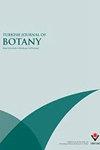The chromosomal evolution and analyses of Turkish Cousinia species
IF 1.5
4区 生物学
Q3 PLANT SCIENCES
引用次数: 0
Abstract
: In this study, Turkish Cousinia species were examined in point of chromosome number and morphology. To our knowledge, this work is the first comprehensive chromosomal study regarding Turkish Cousinia as a whole, especially for endemics. As consistent with previous reports, the chromosome numbers are mostly 2 n = 26 and have been determined also as 2 n = 24 for only the members of Cynaroideae and Sphaerocephalae sections. An interesting result of this paper is that there is not any polyploid species in this taxonomic group and all of them are diploids. Concerning the chromosome evolution of the Cousinia species, we concluded that merely dysploidy is effective within the genus and evolutionally a unipolar reduction goes on in the basic chromosome number in speciation (from 13 to 12). In terms of general chromosomal information, the chromosomes of the genus consist of metacentric and submetacentric types and they could be categorized in small category according to Lima De Faria classification (0.67–3.43). According to chromosomal indices used in this paper, while most species have symmetrical chromosomes, fewer have asymmetrical ones. From this point, it could be said that Cousinia stapfiana could be assessed as the most evolved taxa in karyomorphology according to the average of all indexes used in here. Besides, Cousinia bicolor , Cousinia birandiana , and Cousinia sintenisii are species having the most primitive chromosome within the genus.土耳其库森菌属物种的染色体进化及分析
本研究从染色体数目和形态两个方面对土耳其库森菌进行了研究。据我们所知,这项工作是首次对土耳其库森菌进行全面的染色体研究,尤其是对地方病学的研究。与之前的报道一致,染色体数量大多为2n=26,并且仅对Cynaroideae和Sphaerocephalae切片的成员确定为2n=24。这篇论文的一个有趣的结果是,在这个分类群中没有任何多倍体物种,它们都是二倍体。关于库森菌属物种的染色体进化,我们得出的结论是,在该属中,仅仅是异倍性是有效的,并且在物种形成中,基本染色体数量在进化上发生了单极性减少(从13个减少到12个)。就一般染色体信息而言,该属的染色体由中心型和亚中心型组成,根据Lima-De Faria分类法(0.67–3.43),它们可以分为小类。根据本文使用的染色体指数,虽然大多数物种的染色体是对称的,但很少有非对称的。从这一点上,可以说,根据本文使用的所有指标的平均值,葡萄球菌可以被评估为细胞核形态学中进化最快的分类群。此外,双色库森菌、双蓝山库森菌和辛特尼西库森菌是该属中染色体最原始的物种。
本文章由计算机程序翻译,如有差异,请以英文原文为准。
求助全文
约1分钟内获得全文
求助全文
来源期刊

Turkish Journal of Botany
PLANT SCIENCES-
CiteScore
2.90
自引率
5.60%
发文量
31
审稿时长
6-12 weeks
期刊介绍:
The Turkish Journal of Botany is published electronically 6 times a year by the Scientific and Technological Research Council of Turkey (TÜBİTAK) and accepts manuscripts (in English) covering all areas of plant biology (including genetics, evolution, systematics, structure, function, development, diversity, conservation biology, biogeography, paleobotany, ontogeny, functional morphology, ecology, reproductive biology, and pollination biology), all levels of organisation (molecular to ecosystem), and all plant groups and allied organisms (algae, fungi, and lichens). Authors are required to frame their research questions and discuss their results in terms of major questions in plant biology. In general, papers that are too narrowly focused, purely descriptive, or broad surveys, or that contain only preliminary data or natural history, will not be considered (*).
The following types of article will be considered:
1. Research articles: Original research in various fields of botany will be evaluated as research articles.
2. Research notes: These include articles such as preliminary notes on a study or manuscripts on the morphological, anatomical, cytological, physiological, biochemical, and other properties of plant, algae, lichen and fungi species.
3. Reviews: Reviews of recent developments, improvements, discoveries, and ideas in various fields of botany.
4. Letters to the editor: These include opinions, comments relating to the publishing policy of the Turkish Journal of Botany, news, and suggestions. Letters should not exceed one journal page.
(*) 1. Raw floristic lists (of algae, lichens, fungi, or plants), species descriptions, chorological studies, and plant sociology studies without any additional independent approaches.
2. Comparative morphology and anatomy studies (that do not cover a family, tribe, subtribe, genus, subgenus, section, subsection, or species complexes with taxonomical problems) without one or more independent additional approaches such as phylogenetical, micromorphological, chromosomal and anatomical analyses.
3. Revisions of family, tribe, genus, subgenus, section, subsection, or species complexes without any original outputs such as taxonomical status changes, IUCN categories, and phenological and ecological analyses.
4. New taxa of all plants without any additional independent approaches such as phylogenetical, ecological, chromosomal, chorological and correlational analyses in addition to a detailed macro- and micro-morphological descriptions with quality field and microscopic illustrations of taxonomically important structures and identification key in the taxonomic group.
New records of all plants without any additional independent approaches such as phylogenetical, ecological, chromosomal, chorological and correlational analyses in addition to a detailed macro- and micro-morphological descriptions with quality field and microscopic illustrations of taxonomically important structures and identification key in the taxonomic group may be accepted for peer review if they contain 3 or more new records or taxonomical status update, such as lectotypification, new combinations, transfers, revivals and synonyms.
5. New taxa of algae, lichens, and fungi without any additional independent approaches such as phylogenetical, ecological, chromosomal, chorological and correlational analyses in addition to a detailed macro- and micro-morphological descriptions with quality field and microscopic illustrations of taxonomically important structures and identification key in the taxonomic group.
New records of algae, lichens, and fungi without any additional independent approaches such as phylogenetical, ecological, chromosomal, chorological and correlational analyses in addition to a detailed macro- and micro-morphological descriptions with quality field and microscopic illustrations of taxonomically important structures and identification key in the taxonomic group may be accepted for peer review if they contain 5 or more new records or taxonomical status update, such as lectotypification, new combinations, transfers, revivals and synonyms.
 求助内容:
求助内容: 应助结果提醒方式:
应助结果提醒方式:


